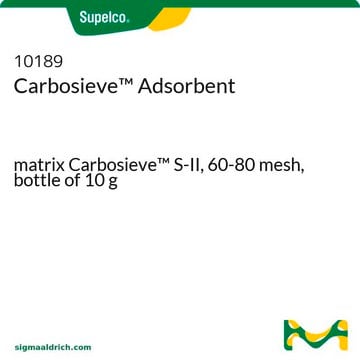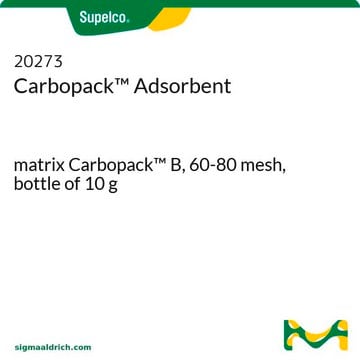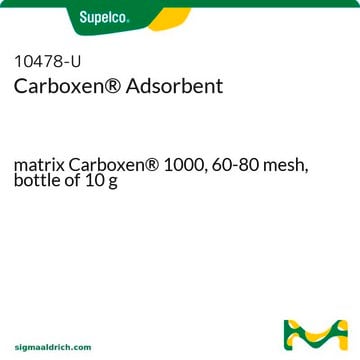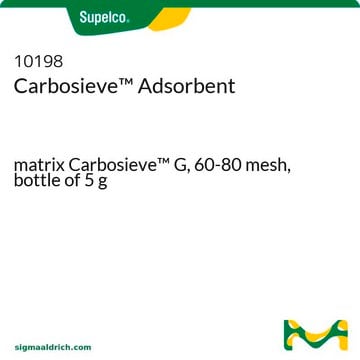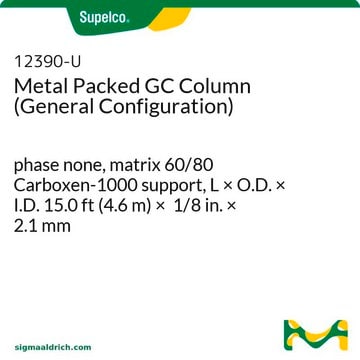10190-U
Carbosieve Carbon Adsorbent
matrix Carbosieve S-II, 80-100 mesh, bottle of 10 g
Sinonimo/i:
polymeric adsorbent, DVB, 80-100 mesh
About This Item
Prodotti consigliati
Nome del prodotto
Carbosieve Adsorbent, matrix Carbosieve S-II, 80-100 mesh, bottle of 10 g
Nome Commerciale
Carbosieve
Livello qualitativo
Stato
powder or granules
Confezionamento
bottle of 10 g
tecniche
LPLC: suitable
gas chromatography (GC): suitable
solid phase extraction (SPE): suitable
Area superficiale
~1059 m2/g
Matrice
Carbosieve S-II
Gruppo funzionale matrice
carbon
Dimensione particelle
80-100 mesh
Dimensione pori
~0.01 cm3/g mesoporosity
~0.45 cm3/g microporosity
~0 cm3/g macroporosity
~6-15 Å pore diameter
Densità
~0.61 g/mL (free fall density)
Tecnica di separazione
reversed phase
Cerchi prodotti simili? Visita Guida al confronto tra prodotti
Descrizione generale
- Spherical (better packed bed performance than granular particles)
- Hard and non-friable (pack well, will not break)
- Highly porous (high surface areas)
- Used for molecules with an analyte size relative to C2-C5 n-alkanes
- Hydrophobic (can be used in high humidity environments)
Generally, CMS adsorbents offer greater relative adsorptive strength compared to spherical graphitized polymer carbon (SGPC) and graphitized carbon black (GCB) adsorbents. Our Carbosieve products are a type of CMS adsorbent.
- Have non-tapered pores
- Very strong adsorptive strength due to only containing micropores
- Provide great performance for many small, volatile analytes that most adsorbents have trouble retaining
For more information about any of our specialty carbon adsorbents, please visit sigma-aldrich.com/carbon
Note legali
Codice della classe di stoccaggio
11 - Combustible Solids
Classe di pericolosità dell'acqua (WGK)
nwg
Punto d’infiammabilità (°F)
Not applicable
Punto d’infiammabilità (°C)
Not applicable
Dispositivi di protezione individuale
Eyeshields, Gloves, type N95 (US)
Scegli una delle versioni più recenti:
Certificati d'analisi (COA)
It looks like we've run into a problem, but you can still download Certificates of Analysis from our Documenti section.
Se ti serve aiuto, non esitare a contattarci Servizio Clienti
Possiedi già questo prodotto?
I documenti relativi ai prodotti acquistati recentemente sono disponibili nell’Archivio dei documenti.
Articoli
Synthetic CMS carbons offer tailored adsorbents for specific applications.
Il team dei nostri ricercatori vanta grande esperienza in tutte le aree della ricerca quali Life Science, scienza dei materiali, sintesi chimica, cromatografia, discipline analitiche, ecc..
Contatta l'Assistenza Tecnica.